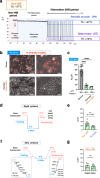Hepatic resistance to cold ferroptosis in a mammalian hibernator Syrian hamster depends on effective storage of diet-derived α-tocopherol
- PMID: 34172811
- PMCID: PMC8233303
- DOI: 10.1038/s42003-021-02297-6
Hepatic resistance to cold ferroptosis in a mammalian hibernator Syrian hamster depends on effective storage of diet-derived α-tocopherol
Abstract
Mammalian hibernators endure severe and prolonged hypothermia that is lethal to non-hibernators, including humans and mice. The mechanisms responsible for the cold resistance remain poorly understood. Here, we found that hepatocytes from a mammalian hibernator, the Syrian hamster, exhibited remarkable resistance to prolonged cold culture, whereas murine hepatocytes underwent cold-induced cell death that fulfills the hallmarks of ferroptosis such as necrotic morphology, lipid peroxidation and prevention by an iron chelator. Unexpectedly, hepatocytes from Syrian hamsters exerted resistance to cold- and drug-induced ferroptosis in a diet-dependent manner, with the aid of their superior ability to retain dietary α-tocopherol (αT), a vitamin E analog, in the liver and blood compared with those of mice. The liver phospholipid composition is less susceptible to peroxidation in Syrian hamsters than in mice. Altogether, the cold resistance of the hibernator's liver is established by the ability to utilize αT effectively to prevent lipid peroxidation and ferroptosis.
Conflict of interest statement
The authors declare no competing interests.
Figures




Similar articles
-
Identification of genes supporting cold resistance of mammalian cells: lessons from a hibernator.Cell Death Dis. 2024 Sep 19;15(9):685. doi: 10.1038/s41419-024-07059-w. Cell Death Dis. 2024. PMID: 39300059 Free PMC article.
-
Cold resistance of mammalian hibernators ∼ a matter of ferroptosis?Front Physiol. 2024 Apr 25;15:1377986. doi: 10.3389/fphys.2024.1377986. eCollection 2024. Front Physiol. 2024. PMID: 38725569 Free PMC article. Review.
-
Decreases in body temperature and body mass constitute pre-hibernation remodelling in the Syrian golden hamster, a facultative mammalian hibernator.R Soc Open Sci. 2016 Apr 13;3(4):160002. doi: 10.1098/rsos.160002. eCollection 2016 Apr. R Soc Open Sci. 2016. PMID: 27152216 Free PMC article.
-
Molecular Basis of White Adipose Tissue Remodeling That Precedes and Coincides With Hibernation in the Syrian Hamster, a Food-Storing Hibernator.Front Physiol. 2019 Jan 28;9:1973. doi: 10.3389/fphys.2018.01973. eCollection 2018. Front Physiol. 2019. PMID: 30745884 Free PMC article.
-
Lipid Peroxidation-Dependent Cell Death Regulated by GPx4 and Ferroptosis.Curr Top Microbiol Immunol. 2017;403:143-170. doi: 10.1007/82_2016_508. Curr Top Microbiol Immunol. 2017. PMID: 28204974 Review.
Cited by
-
Identification of genes supporting cold resistance of mammalian cells: lessons from a hibernator.Cell Death Dis. 2024 Sep 19;15(9):685. doi: 10.1038/s41419-024-07059-w. Cell Death Dis. 2024. PMID: 39300059 Free PMC article.
-
Multi-species genome-wide CRISPR screens identify conserved suppressors of cold-induced cell death.bioRxiv [Preprint]. 2024 Nov 19:2024.07.25.605098. doi: 10.1101/2024.07.25.605098. bioRxiv. 2024. PMID: 39091747 Free PMC article. Preprint.
-
Cold resistance of mammalian hibernators ∼ a matter of ferroptosis?Front Physiol. 2024 Apr 25;15:1377986. doi: 10.3389/fphys.2024.1377986. eCollection 2024. Front Physiol. 2024. PMID: 38725569 Free PMC article. Review.
-
Cold-induced suspension and resetting of Ca2+ and transcriptional rhythms in the suprachiasmatic nucleus neurons.iScience. 2023 Nov 3;26(12):108390. doi: 10.1016/j.isci.2023.108390. eCollection 2023 Dec 15. iScience. 2023. PMID: 38077129 Free PMC article.
-
Exogenous LEA proteins expression enhances cold tolerance in mammalian cells by reducing oxidative stress.Sci Rep. 2025 Jan 27;15(1):3351. doi: 10.1038/s41598-025-86499-6. Sci Rep. 2025. PMID: 39870738 Free PMC article.
References
-
- Andrews, M. T. Molecular interactions underpinning the phenotype of hibernation in mammals. J. Exp. Biol. 222, 10.1242/jeb.160606 (2019). - PubMed
Publication types
MeSH terms
Substances
LinkOut - more resources
Full Text Sources

